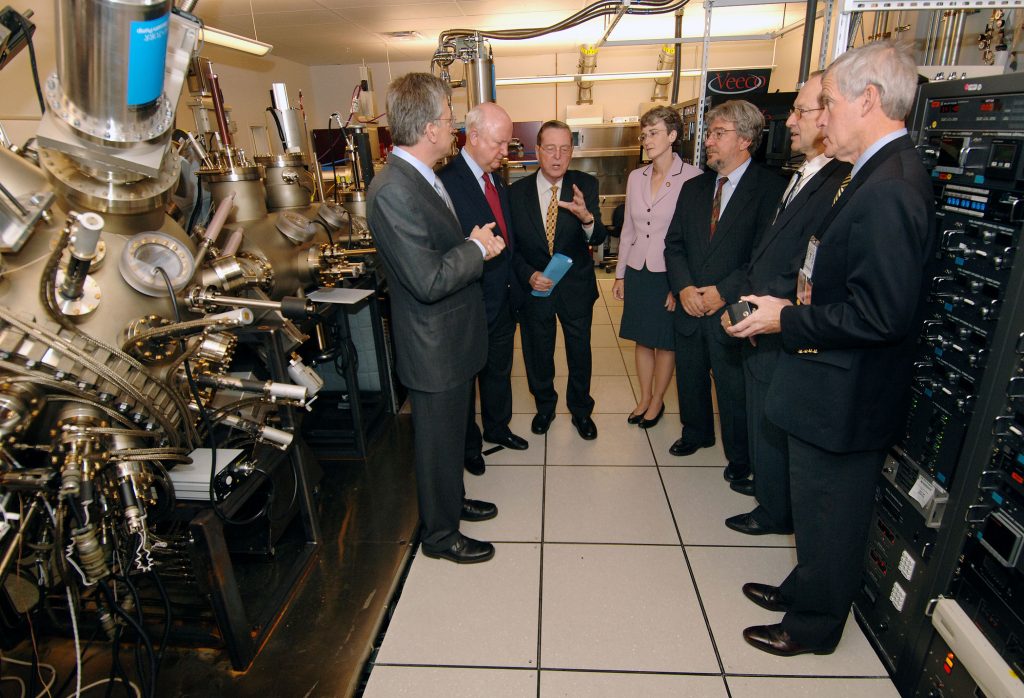
Download 300dpi JPG image, “cint-lab-20061005.jpg,” 672K (Media are welcome to download/publish this image with related news stories.)
ALBUQUERQUE, N.M. — U.S. Department of Energy (DOE) Secretary Samuel W. Bodman announced today that Sandia National Laboratories is the new home of the National Laboratory Center for Solid-State Lighting Research and Development. He made the announcement at a news conference at Sandia’s International Programs Building.
Sandia will conduct vital solid-state lighting research and coordinate related research efforts at several other national laboratories.
DOE will provide funding of $5 million for seven research projects in solid-state lighting, including $2.6 million for four Sandia projects, Bodman said. The funding comes from DOE’s Office of Energy Efficiency and Renewable Energy.
Sandia is a National Nuclear Security Administration laboratory.
“The research will be conducted at the new nanotechnology centers at our national laboratories,” Bodman said, including the just dedicated Sandia/Los Alamos Center for Integrated Nanotechnologies (CINT). “This is part of nearly $20 million we are committing this year to support research and development efforts in this rapidly emerging technology.”
Also in attendance at the news conference were National Nuclear Security Administration Administrator Linton Brooks, Sandia President and Laboratories Director Tom Hunter, Sens. Pete Domenici, R-N.M., and Jeff Bingaman, D-N.M, Rep. Heather Wilson, R-N.M., and Los Alamos National Laboratory Director Michael Anastasio. Before the announcement, the entourage got a tour and briefing about the Center for Integrated Nanotechnologies (CINT) and its capabilities.
Bodman laid out the case for investment in solid-state lighting R&D, noting that 18 percent of all US energy generated — valued at some $55 billion — goes to lighting homes, offices, and factories.
“We believe a set of revolutionary new technologies called solid-state lighting,” Bodman said, “offer excellent prospects for meeting our future lighting needs in a less costly, more efficient way than today’s incandescent and even fluorescent fixtures. . . . We at the Department of Energy want to see it fully developed as quickly as possible.
“We also believe that solid-state lighting presents an excellent opportunity for the U.S. to assume a leadership role in an emerging industry that can generate thousands of high-paying, high quality jobs in the years ahead and help maintain the U.S. economy’s strong record of global leadership in growth and jobs creation.”
Regarding jobs creation, Bingaman in prepared remarks said he hoped the tens of thousands of high-paying jobs that will emerge in this budding industry in the next few years will stay in the U.S. — and in New Mexico — rather than go overseas. Bingaman, an early and ardent supporter of investment in solid-state lighting R&D, said in a news release distributed in conjunction with Bodman’s announcement, “It makes sense that this research will be done right here at Sandia, where scientists are already hard at work developing this technology.”
During the news conference, Bingaman singled out Jerry Simmons, senior manager of Sandia’s Energy Sciences Department, for his “many years of working in the vineyards” of solid-state lighting research.
Domenici praised DOE for making the investment in solid-state lighting research. He said there are many ways the nation can address the issue of the over-consumption of crude oil from overseas. He said the investment in solid-state lighting R&D is a tangible demonstration that the current administration cares about the issue and is funding research that can actually help reduce energy use.
Domenici predicted a bright future for solid-state lighting. “There will be spin-offs” from this research, he said, and the labs involved will find “the longest waiting list they’ve ever seen” for partners from industry and academia eager to collaborate on research projects.
“It is going to be rather exciting to watch,” he said.
Wilson noted that for every intersection in Albuquerque where the traffic signals have been changed to use LED lights, the city saves about $1,000 a year.